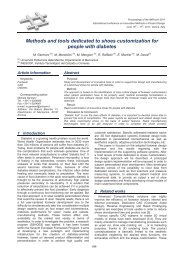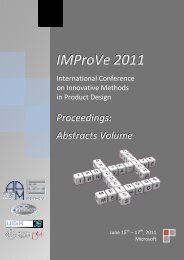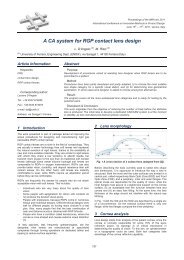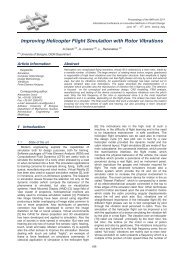IMProVe 2011 - Proceedings
IMProVe 2011 - Proceedings
IMProVe 2011 - Proceedings
Create successful ePaper yourself
Turn your PDF publications into a flip-book with our unique Google optimized e-Paper software.
Simulation and Experimental Approaches<br />
characterize each element. In numerical models the tappet is represented as constituted<br />
by the tappet and The aim of present work is the containment of the inertia forces, the<br />
stiffness components optimization and the fit tolerances of valve train in internal<br />
combustion engines 4T.<br />
The proposed methodology allows, through the development of a test machine, the<br />
evaluation of axial stiffness of tappet depending on eccentricity of the cam tappet contact,<br />
performing a functional analysis that simulate the behaviour of the system in operational<br />
condition, even if, some adjustment of tolerances of the fit between tappet and his guide,<br />
occurred.<br />
The dynamic study of the valve train, through modern computer codes, is performed by<br />
connecting lumped masses, springs and dampers that characterize each element. In<br />
numerical models the tappet is represented as constituted by the tappet and by the<br />
hydraulic element. Each of these elements is characterized by stiffness and mass. The<br />
structural rigidity of the tappet has, in fact, important effects on the dynamic behaviour of<br />
the entire valve train.<br />
The test machine makes possible the choice of the dimensional and geometrical<br />
tolerances of the fit between tappet and his guide; allows furthermore the evaluation of<br />
errors occurred during construction and integration phase. In addition, the test machine is<br />
also suitable for reverse engineering applications, makes it possible to automatically draw<br />
the cam profile in polar coordinates.<br />
Keywords: Tappet, cam, valve lift, 3D modelling, Reverse engineering.<br />
Corresponding Author: S. Massimo Oliveri<br />
Tel.: +39 095 7382404<br />
Fax.: +39 095 337994<br />
e-mail: moliveri@diim.unict.it<br />
Address: Viale A. Doria, 6 Catania.<br />
An investigation on the validity of 3D clothing simulation<br />
for garment fit evaluation<br />
Y. Y. Wu (a), P. Y. Mok (a), Y. L. Kwok (a), J. T. Fan (a), J. H. Xin (a)<br />
(a) Institute of Textiles and Clothing, The Hong Kong Polytechnic University<br />
Abstract:<br />
Virtual cloth simulation received much attention in the past decade, and the fashion<br />
industry has been attracted to use this newly available tool in actual product development<br />
process to strengthen the collaboration along the supply chain and shorten the product<br />
time to market. This paper serves as an exploratory study to analyse the accuracy of 3D<br />
cloth simulation system so as to examine its validity and effectiveness in garment fit<br />
evaluation. A four-phase methodology is proposed in this paper: 20 types of woven fabrics<br />
are first tested in standard laboratory, and the obtained fabric property data are input to<br />
simulate the results of a flare skirt design. Real sample skirts are produced for comparison.<br />
June 15 th – 17 th , <strong>2011</strong>, Venice, Italy<br />
83<br />
<strong>IMProVe</strong> <strong>2011</strong> - <strong>Proceedings</strong>










